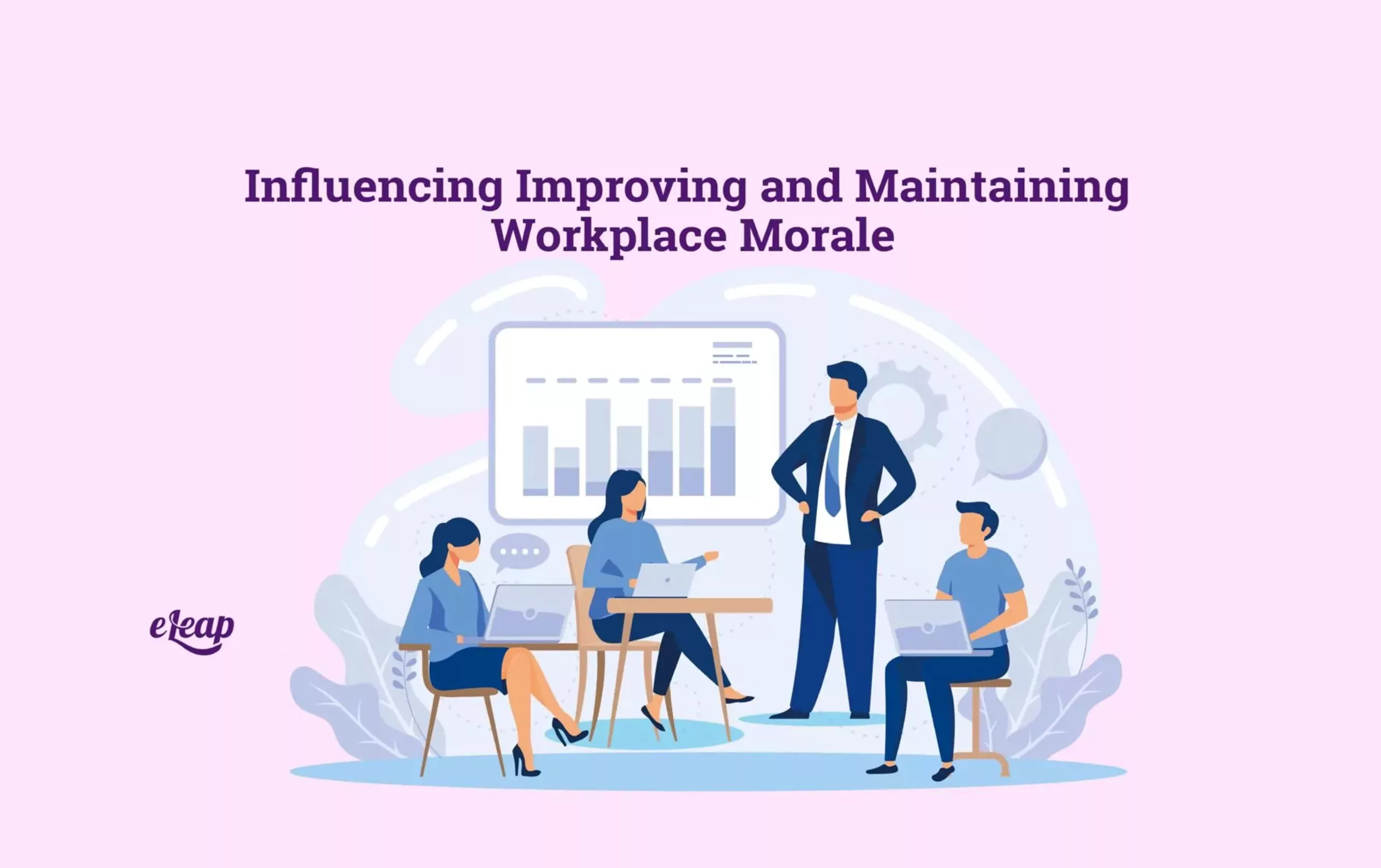Influencing Improving and Maintaining Workplace Morale

Workplace morale is often what makes or breaks employee satisfaction. Employees may take a job based on their interests, compensation, or benefits, while morale influences how long they stay with a company. Thus, workplace morale is important for keeping employee satisfaction at a high level. This reduces turnover and builds successful organizations.
What is Workplace Morale?
Workplace morale pertains to the overall attitude, satisfaction, and outlook of employees during their time spent in the work environment or affiliated with a given company. In other words, it is the feeling an employee gets when they think about or take part in work. It is an important concept that is pivotal for organizational success.
Why Aim for Good Workplace Morale?
When employee turnover runs high in an organization, it costs the business money. Recruiting, interviewing, onboarding, and training new employees all create a run-off of expenses for a business.
Employee dissatisfaction directly and negatively influences the turnover rate; rooting out the potential causes of dissatisfaction helps leaders find ways to improve workplace morale. Satisfied employees lead to good workplace morale, which leads to a decrease in turnover.
6 Factors that Influence Workplace Morale
Numerous things influence employee morale in the workplace. Even those that pertain to the individual worker affect the entire team. If one employee has low morale, it can bring down the rest of the group. These are some factors that influence workplace morale:
1: Employee Work-Life Balance
Maintaining a balance between work life and responsibilities outside the office is a key component of satisfied employees. If their work-life balance feels off to them, it causes them to feel more stressed about work than they normally would, which damages workplace morale.

How to Foster a Good Work-Life Balance for Employees:
- Scheduling Flexibility – Millennials cite this criterion among the most important job benefits. Over 50% of working people say that they would be willing to switch jobs for more scheduling flexibility.
- Remote Work – Many office-oriented jobs can often be adaptable for remote work. Technology keeps today’s workforce well connected. Allowing employees to work remotely gives them a chance to be productive on their terms while feeling more connected to their home life.
- Reasonable Time Off – Creating a good work-life balance means acknowledging there’s more to life than the job. It’s not just about vacation time. Workers raise families, run households, and live the lives they work hard to provide for. It’s not possible to do any of those things without spending time out of the office on occasion.
Even if employees love their job, there are still probably a hundred other places they would rather be than at work. Therefore, maintaining a work-life balance is important.
2: Value of the Work
Many employees are most satisfied when they feel the work they are doing is making a positive impact on the world around them. For example, a worker on an assembly line repeatedly putting a single component into an unfinished item may struggle to see the big picture and the positive impact of the finished product.
To help employees see the value of their role in the workplace, management should educate employees on the trickle-down effect of their efforts.
Consider the assembly worker mentioned. If they knew that the product they were helping to build was a key safety component in a child’s car seat, they would have a point of reference for the value of their work. Picturing the finished product in action motivates them to do their job with precision and efficiency, even if they work on a car seat at a point in its manufacturing in which it is unrecognizable.
When employees feel the work they are doing is meaningful, they go much longer without experiencing burnout. The purpose behind their daily tasks invigorates them and they take pride in their employee role.
3: Benefits
A benefits package is a third thing that influences workplace morale privacy, whether it’s good or bad. Employer benefits ease employee stress over health insurance coverage and retirement savings.
Though benefits packages are common, not every employer has them. For those without, employees seek health insurance and savings plans on their own. It’s not difficult to do so. However, compared to the convenience of the employer taking care of these things, many employees notice the absence of such perks.
Lack of a benefits package could result in employees holding a subconscious resentment towards their employer for not having access to benefits they might have elsewhere.
4: Professional Development and Advancement
Workplace morale is also influenced by employee confidence in their role. Continuous training to perfect current skills boosts employee confidence. It often even comes in the form of advancement opportunities within the organization.
There are absolutely zero downsides to encouraging employees to better themselves. Professional growth creates more confident, driven, and happier workers. They find satisfaction in their jobs and feel supported by their employer. This results in increased productivity for the organization.
The day may come when an employee outgrows what their current company can offer them. Even if the employee moves on, this is not a negative thing.
They will always reflect on that employer positively. They will recognize it as the environment that catalyzed their ongoing development. This could potentially lead to the referral of other driven and effective employees to take their place.
5: Good Management
Good or bad leaders can make or break a team; those who are effective leaders can do wonders for improving workplace morale wellness. Great leaders know how to communicate with and motivate their subordinates to perform while making sure they feel supported and appreciated. At the same time, employees led by good managers are more likely to be happy at work and remain at their current company for longer.
An effective team leader is also adept at giving constructive criticism when necessary; they do so in a way that makes the receiving employee feel confident. Good leaders in these situations are the difference between employees getting frustrated enough to quit and employees feeling confident and empowered to move towards solutions.
6: Employee Recognition
Not everyone needs a cheerleader to perform and feel appreciated for their performance on the job, but many hard-working employees appreciate getting a pat on the back for their efforts.
Some effective forms of employee recognition include:
- Thank you notes
- Appreciation message boards
- Public acknowledgment
- Performance bonuses
Employee recognition is a morale booster that requires very minimal effort to facilitate, but still makes a huge positive difference in workplace morale.
How to Measure Workplace Morale through Employee Feedback and Reviews
To make sure workplace morale is at a level beneficial to an organization’s employees, managers must find a way to gather information about employee satisfaction. Quantifying this information helps identify patterns. It also highlights both positive morale influences and problematic issues that need addressing.
There are a couple of ways to gather this information directly from employees:
Employee Surveys
Employee surveys are great ways to gather information directly from employees. They allow management to ask targeted questions about employee satisfaction. The surveys are written with questions linked to a rating scale.
Here are some popular examples of survey questions that could be answered using a rating system:
- How satisfied are you with your work?
- Do you feel supported by your supervisor?
- Do you feel as though you are clear on the expectations of your job description?
- Do you feel you have adequate resources to do your job effectively?
- Do you have a good work-life balance?
- Are you provided with enough professional development opportunities?
- Is the work you’re doing valuable?
- Do you feel recognized and appreciated for the effort you bring to the workplace?
The resulting feedback gives team leaders concrete numbers, such as exactly how many employees feel satisfied at work, exactly how many feel unsatisfied, etc. Quantifying the results helps employers see exactly which areas of morale influences need adjustment.
Performance Reviews
Most well-structured organizations conduct various formats of routine performance reviews with their employees. These sessions enable an exchange of feedback between management and their employees or between employees and their peers.
Like employee surveys, the format includes targeted questions. The reviews also facilitate a more free-form feedback exchange, in which either party can give feedback in their own words. This allows employers to gain the insight they might have missed if the employee completed a survey.
Workplace Morale: A Key to Employee Satisfaction
While organizations want hard workers, many of them understand they can’t keep them without some effort, such as maintaining employee satisfaction and monitoring morale among staff members. Measuring workplace morale is essential to understanding how to improve it when necessary.
Employees who feel supported, compensated, recognized for their hard work, and that they are doing something meaningful are much more likely to influence higher workplace morale. This makes them much more likely to stay with companies for a long time as well as be effective employees while they are there, leading to increased organizational success.